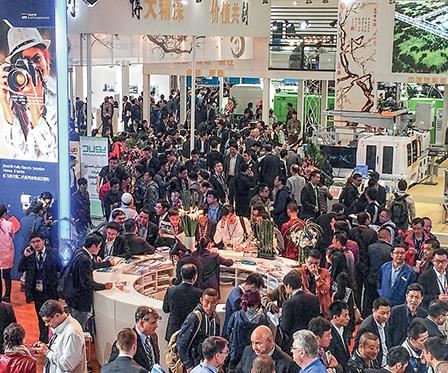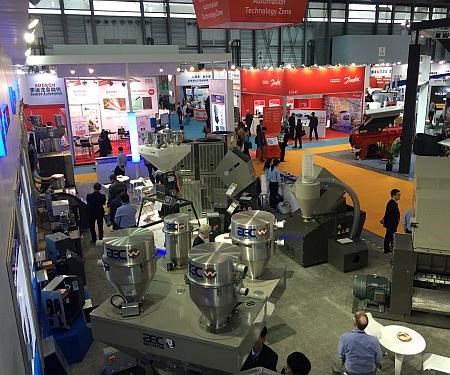‘New Normal’ Marks 30th Chinaplas Show
Show breaks attendance records as Chinese economy slows.
“The objective for Chinaplas is not to be largest show in the world.” That was the response of Stanley Chu, chairman of Chinaplas organizer Adsale Exhibition Services Ltd., Hong Kong, when asked about the possibility of moving his massive show to a newer and even larger venue in Shanghai. The comment came during a press conference before Chinaplas began last month at the Shanghai New International Exhibition Center. Over the next four days, and despite Chu’s statement, Chinaplas shattered more of its own records.
The 148,575 visitors marked an all-time high, and a significant jump over recent shows, eclipsing Chinaplas 2015 in Guangzhou by nearly 16% and topping the most-recent Shanghai event in 2014 by 14%, when just over 130,000 attendees came to the Pudong district of Shanghai. This year’s 30th edition of the show covered 2.58 million ft2, including 430,000 ft2 of outside tent space.
The massive show came at a time of uncertainty for its host country, with China’s 2015 GDP growth of 6.9% its weakest in 25 years. In the first quarter of 2016, growth slowed further to 6.7%. World exports of plastics and rubber machinery to China from 2013 to 2014 were essentially flat. As difficult as it is to describe nearly 7% GDP growth as weak, China’s breakneck growth is slowing down, a fact acknowledged by exhibitors.
Philippe Hanck, business director for DuPont Performance Materials in Asia Pacific, announced at Chinaplas that his company would open this month its largest compounding operation in the world in the Guangming New District of Shenzhen.
Asked about the timing, given China’s recent economic uncertainty, Hanck acknowledged that “there is a slowdown, there is a new normal, but our growth is not necessarily directly linked with growth of the overall industry.” Hanck noted, for example, that in some specialized segments that DuPont serves in automotive and packaging, there is very good activity in China. “This new compounding plant is really essential to continue to serve our customers with a majority of locally produced polymers,” he added.
Solvay Engineering Plastics, Augusta, Ga., which established its first operation in China over two decades ago, announced at Chinaplas that it was opening a dedicated part-testing laboratory in Shanghai—its first Application Performance Testing (APT) center outside Europe. The goal is to accelerate the development and validation of applications using Solvay’s Technyl nylons for for automotive, consumer, and electrical parts.
ExxonMobil Chemical, Houston, used Chinaplas to make a major product announcement, launching its new Exceed XP family of polyethylene at the show (learn more).
Gero Willmeroth, sales and service president at Engel Machinery Shanghai, also acknowledged China’s new normal, adding that it is a positive development. “The new normal means we have to realize that 10% or bigger growth rates are over, and we’re now more in the range of 6-7%,” Willmeroth says. “The economy is not shrinking—it’s just growing at a slower pace, and it will create new opportunities. When the economy slows down, people focus on their productivity and strengthening their competitive advantage—that benefits Engel.”
In response to its own growth in China, and only four years removed from doubling the capacity of its machine-building plant in Shanghai, Engel announced at Chinaplas that it is adding another building at that site to support manufacturing and administration, with about 17,200 ft² of additional production space, including a new heavy-duty machining center for platen manufacturing. To be completed by April 2017, the addition, including machinery, constitutes an investment of $9.2 million.
In a twist, KraussMaffei has used its manufacturing plant in Haiyan—its only full-scale machine-building operation outside of Munich—to support growing demand in the U.S. KM notes that Haiyan’s relative flexibility compared with its main manufacturing site has allowed it to quote much shorter lead times for presses.
For many U.S. molders, that shorter lead time—up to three to four months not counting shipping time from China—has prompted them to order presses from KM in China. In fact, KM reports that the factory in Haiyan exports up to one-third of its production to the U.S.
Auxiliary equipment supplier ACS Group, New Berlin, Wisc., took the concept of local sourcing/design/production to the next level at Chinaplas, introducing its IC (In China) line of products that are designed, made and sold in China. “We basically decided that we won’t sell American products into China,” said Paul Grekowicz, VP of marketing and product development at ACS Group. “We asked our Chinese customers what they care about, what’s more important, and what they don’t care about in terms of features.”
The IC line currently includes a blender, chiller, temperature control unit and granulator. The equipment had been operating at beta sites before the show, and Grekowicz was happy to announce that several of the beta-site customers didn’t want to give back their IC equipment. To support this move, Grekowicz said ACS upgraded its Suzhou manufacturing site, which it opened in 2007, adding equipment and increasing capacity. Drying equipment will the next to receive the IC treatment, according to Grekowicz.
Related Content
Recycled Material Prices Show Stability Heading into 2023
After summer's steep drop, most prices leveled off in the second half.
Read MoreFundamentals of Polyethylene – Part 3: Field Failures
Polyethylene parts can fail when an inappropriate density is selected. Let’s look at some examples and examine what happened and why.
Read MorePrices of All Five Commodity Resins Drop
Factors include slowed demand, more than ample supplier inventories, and lower feedstock costs.
Read MoreThe Fundamentals of Polyethylene – Part 2: Density and Molecular Weight
PE properties can be adjusted either by changing the molecular weight or by altering the density. While this increases the possible combinations of properties, it also requires that the specification for the material be precise.
Read MoreRead Next
Understanding Melting in Single-Screw Extruders
You can better visualize the melting process by “flipping” the observation point so that the barrel appears to be turning clockwise around a stationary screw.
Read MoreAdvanced Recycling: Beyond Pyrolysis
Consumer-product brand owners increasingly see advanced chemical recycling as a necessary complement to mechanical recycling if they are to meet ambitious goals for a circular economy in the next decade. Dozens of technology providers are developing new technologies to overcome the limitations of existing pyrolysis methods and to commercialize various alternative approaches to chemical recycling of plastics.
Read MoreProcessor Turns to AI to Help Keep Machines Humming
At captive processor McConkey, a new generation of artificial intelligence models, highlighted by ChatGPT, is helping it wade through the shortage of skilled labor and keep its production lines churning out good parts.
Read More










.png;maxWidth=300;quality=90)

















